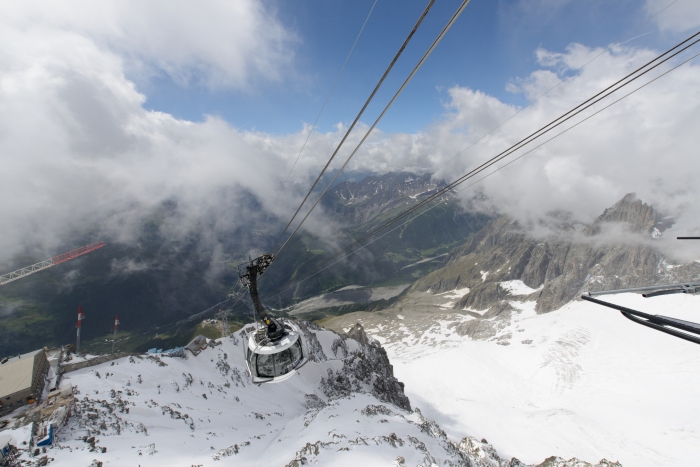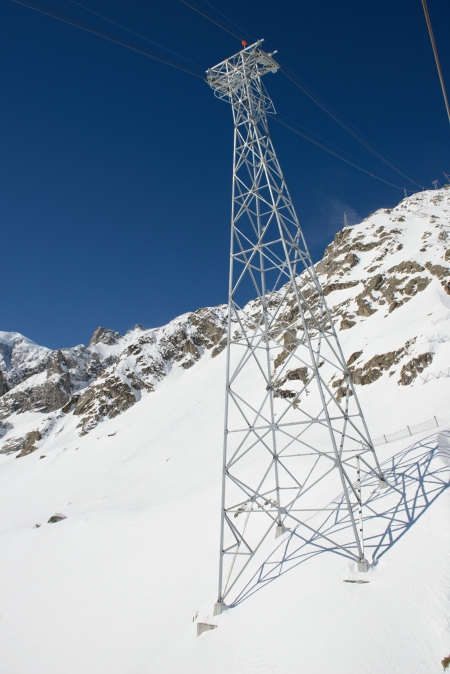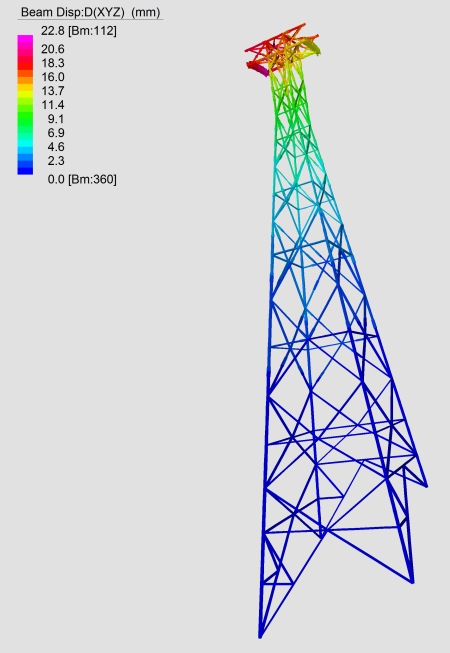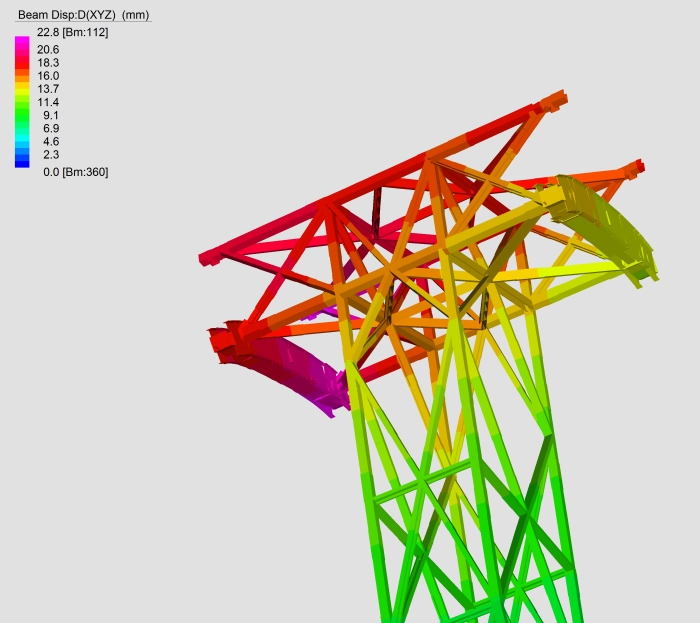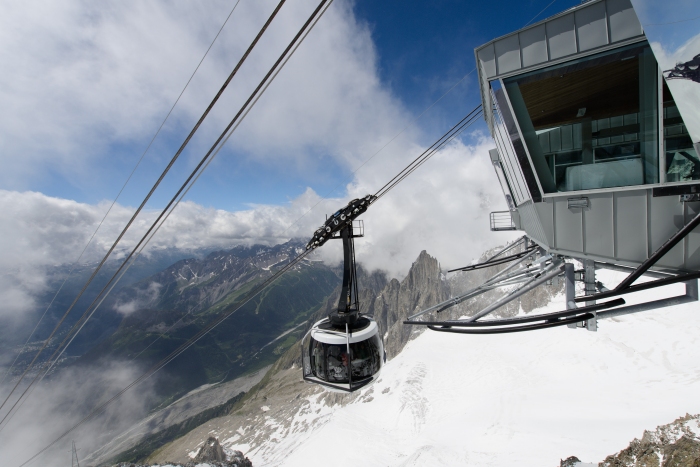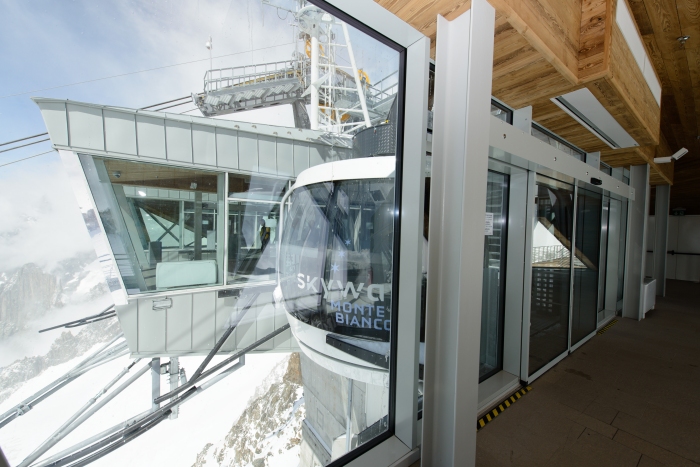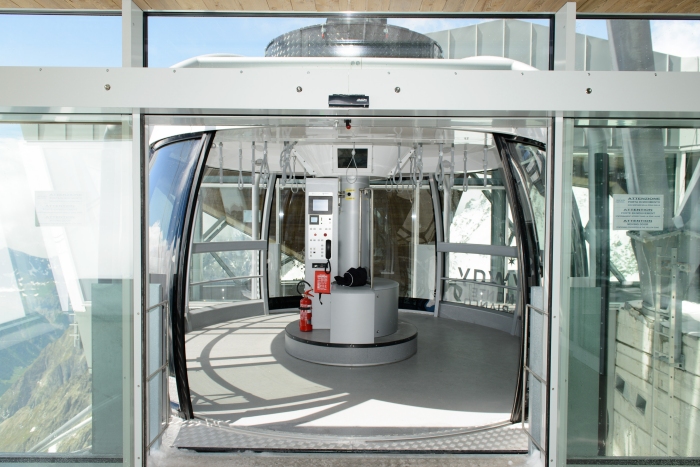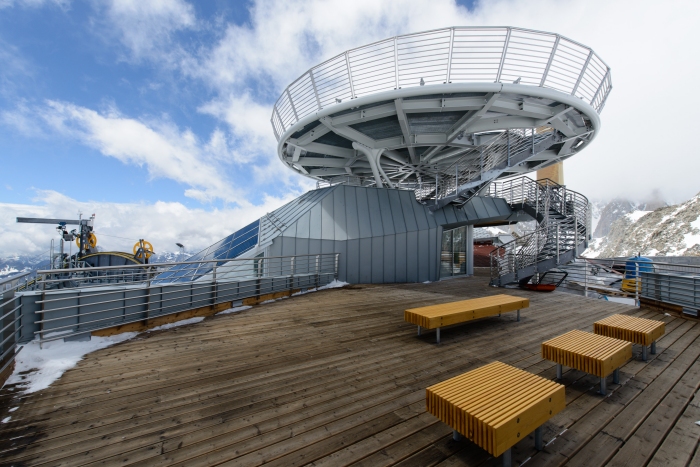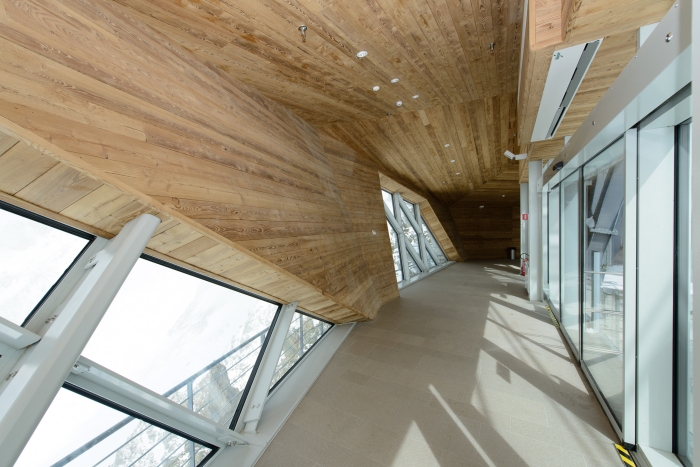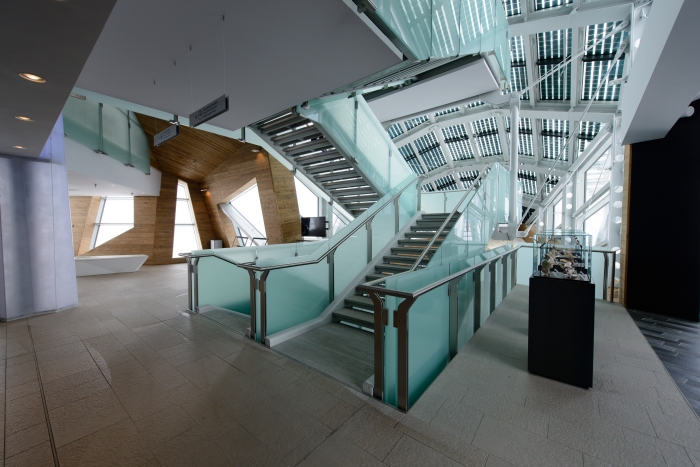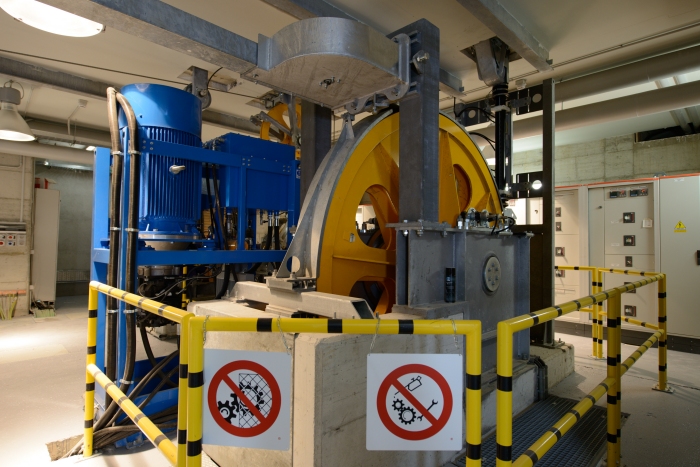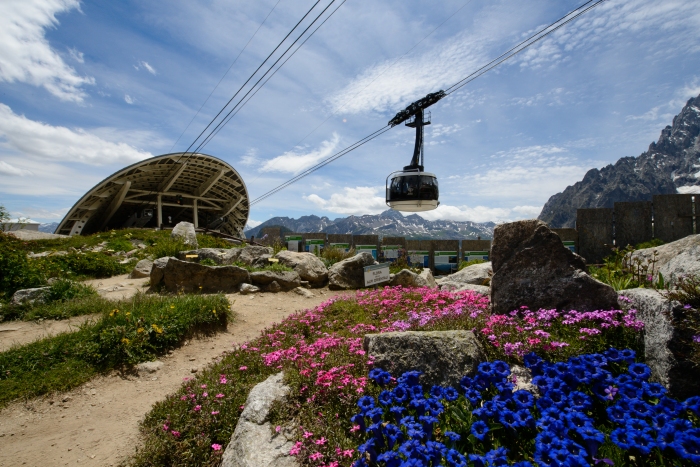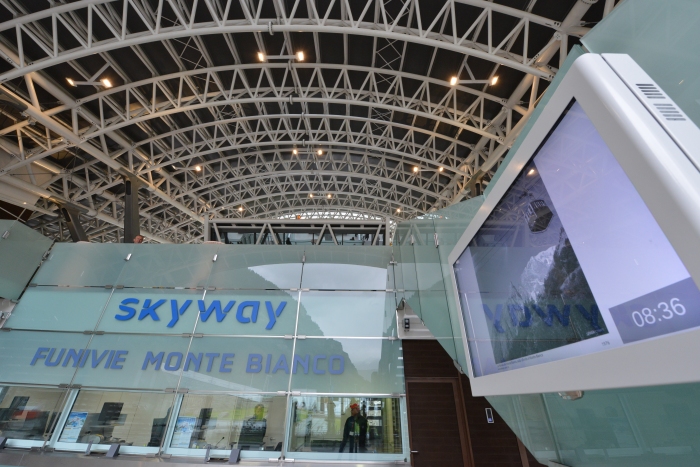|
Created in the mid-twentieth century by the visionary dream of Count Lora Totino, the Mont Blanc Cableways have been transformed into a technological marvel, a world class piece of engineering for a memorable travel experience: Mont Blanc Skyway opened its doors in the month of June 2015.
The new name, Mont Blanc Skyway, underlines a change in perspective: the cable cars are no longer just a means of transportation, but also of conveying exceptional emotions suspended in balance between the earth and the sky. The clear glass views of the silent cable cars, the glass and steel design of the stations, and multimedia installations surprise visitors and accompany them gently and safely in the discovery of the Roof of Europe. Although remarkable, the size of the installation never steals the show from the one true star, the mountain: the contact with nature - mountain vegetation, snow, stone, wind - gives one the freshness of an authentic and exciting sensory experience. No longer just spectators, tourists can now feel part of the world they observe.
The Mont Blanc Skyway brand name is the image of an incredible and unprecedented feat of technology and engineering, which took place with the full respect of a unique environment, a heritage to value and protect for future generations: Mont Blanc, the real heart and engine of this adventure.
Hailed as the Eighth Wonder of the World, the Cableways are a historic gateway to some of Mont Blanc's most priceless treasures. The scenery from the circular terrace on top of Punta Helbronner at 3,466 m, the closest point to the summit of Mont Blanc accessible by public transport and also point of departure for several alpine trails, will leave you breathless. Freeride skiers can start from here on some of the most beautiful off-piste routes in the Alps: the Toula and Marbrées glaciers, the 24 km of the Vallée Blanche leading up to Chamonix, the majestic Brenva glacier, and the Aiguille d'Entrèves area. In the Summer you have access to the Saussurea alpine botanical garden.
The stations
The three stations, Pontal d'Entrèves at 1300 m, Pavillon du Mont Fréty at 2200 m, and Punta Helbronner at 3466 m, are connected by two cableway sections, which are protected spaces built in glass and steel that harmonize with the surrounding environment. The new departure station of Pontal d'Entrèves, which replaces the historic La Palud, is an imposing, aerodynamic-looking structure with large, partly underground and partly uncovered parking lots that can accommodate up to 350 cars and ten buses. Inside are information booths, bars, an infirmary, and ticket offices, in addition to the technicians who look after the powerful engines that drive the cable cars.
The intermediate station, the Pavillon du Mont Fréty, offers a panoramic view on the opposing sides of the Val Veny and Val Ferret, enhanced by the large glass surfaces of the buildings. On the outside, there is a botanical garden, several routes to get close to nature, and a solarium; on the inside, there are two restaurants, a bar, a 150-seat meeting/ events/cinema room, a Mont Blanc crystals exhibit, a small shopping center, and a winery. The old station will be renovated and converted into a museum area.
The last station is Punta Helbronner; it is shaped like a crystal and soars upwards with cantilever terraces. The main attraction is here: a circular scenic terrace 14 meters in diameter with a unique all around view over most of the highest peaks of the Western Alps: Mont Blanc, Monte Rosa, the Matterhorn, the Gran Paradiso and the Grand Combin. Inside, a crystal exhibition hall, a self service restaurant, a bar, and multimedia information points. Numerous multimedia screens located in all the stations inform tourists about the history of the place. Even with bad weather, coming here will not be a missed chance, but a rewarding visit and unforgettable experience where breathing "thin air" will not be the only memory.
The cable cars
They feature a sober and clear hemispherical design with no corners or edges; these airy and light structures are extremely safe, and vibration and noise free. They boast a higher load capacity (80 people compared to the current 20) and rotate a full 360 degrees along the route, affording a full view of the surrounding peaks though their large glass surfaces. A special heating system avoids condensation, while sensors and panels located beneath the floor prevent ice from forming. On board are low consumption LED lighting and multimedia systems such as TV screens for film projection, information on the weather, slopes, avalanche risk, schedules, and events. A camera located on the floor shows images of the panorama below. Special oscillation blocking instruments make the cable car's motion incredibly fluid, adapting to load distribution and weight.
Realizing the project (2011-2015)
The construction work, which lasted four years at the highest site in Europe (also known as "building site in the clouds"), deserves the attention that one reserves to large enterprises engaging in collective efforts that challenge the limits of what is considered "possible". A professional challenge that required great adaptability.
It was 31 March 2011 when the first workers walked into Pontal d'Entreves to build the New Mont Blanc Cableways; it had taken more than 10 years to fulfill all the technical and administrative requirements. Right from the start, the underground of what was to become the departure station turned out to be much more water-rich than expected. Although there were many uncertainties, we were ready to face the unexpected. Before long, countermeasures were set in place to consolidate the excavation face and avoid any cave-in, the area was reclaimed and consolidated.
The preparation work proceeded at a frantic pace; helicopters carried the first materials and detachable vehicles on the sharp ridge of Punta Helbronner at 3466 meters. This would become the scene of construction activities for the main station.
It was time to build what in a few years would become Mont Blanc Skyway. It all seemed like a bet at that time; the weather, the altitude, the working conditions, the excavation of the 150-meter tunnel and the well at over 3000 meters above sea level, the wind and the feet of snow that had to be removed every Winter did not make the job any easier. By the end of 2011, the tunnel had been completely excavated with the pilot hole connecting the station of Punta Helbronner (3,466 m) with the terrace of Refuge Torino (3,375 m) for the first time. This was the necessary prelude to the dismantling of the old station of the third section of the cableways, which would take place in Spring of 2012; this had to be done to make room for the new station being built, the access area for tourists had grown more complex, mountain safety and livability had to be protected especially for them. Taking down a station on a rocky outcrop at over 3500 meters is not easy; it was also necessary to safeguard the stability of the French station of Aiguille du Midi, where the French cable car "Panoramique" was anchored.
Helicopters and service cableways allowed the high altitude transportation of construction vehicles and materials. Logistics and the constant supply of what was necessary were critical and essential elements to be able to build day after day, piece by piece, without a hitch. The cranes, which are still out at Punta Helbronner and will soon be definitively removed, (you can see some images on www.nuovefuniviemontebianco.com) give an idea of what it meant to work up there; because of the storms, the snow would stick to them like whipped cream. The cold, altitude, and lack of oxygen had workers operate under extreme conditions; in order to acclimatize and then recover, they would alternate 7 working days and 4 days off. They were subjected regularly to specialist examinations at the Aosta Mountain Medical Center, which monitored their physical and health conditions on a constant basis.
A steel and concrete barrier was later built to consolidate the mountain before the excavations and then, defying the cold, ice and storms, vehicles and men began the dismantling work, which progressed day and night; it was necessary to complete the demolition work and the excavation of the structural well in addition to preliminary reconstruction before Winter. The 80-meter-deep well was excavated in the heart of Punta Helbronner. It is a structural element designed to consolidate the mountain and make sure it will withstand the "tugging of the ropes" in the decades to come; the jagged rock that makes up the tip was immediately observed to have a particularly fragmented geological structure.
The complex construction of the pylon, the second highest in the world, a little giant of 100 meters, took place in Spring of 2014.
The first cable cars arrived at night in the Fall of 2013. An Austrian company had met the challenge to build 80-seat rotating cable cars. Once around on every trip so all passengers can enjoy the surrounding landscape.
By "pulling" the 4 hauling ropes of the second section (Pavillon du Mont Fréty/Punta Helbronner), the cableways came definitely into being in the Winter of 2014-2015.
The men who made this possible working day and night are not heroes, they are just people who believed in the project from the beginning with tenacity and perseverance, and understood that their work, each for their own part, was the key to the project's success.
The work, was completed first half of 2015, and opened in the month of June 2015.
(c) Copyright 2015 HSH srl Padova I - E-mail hsh@iperv.it For further information about Straus7 please contact us by e-mail: straus7@hsh.info |
